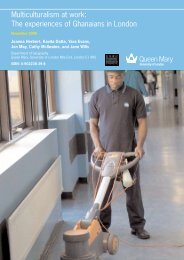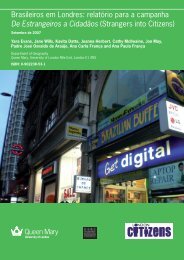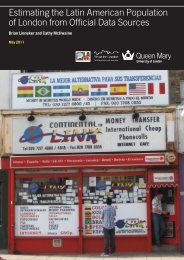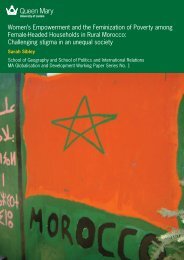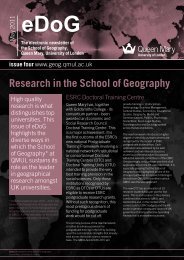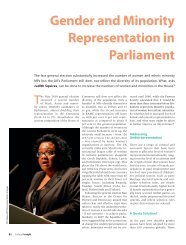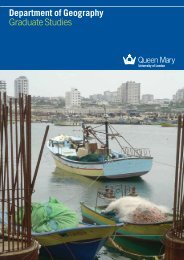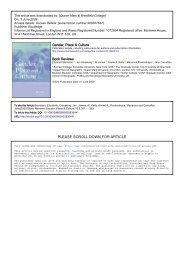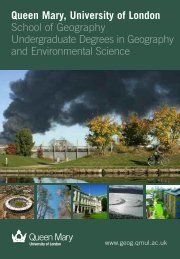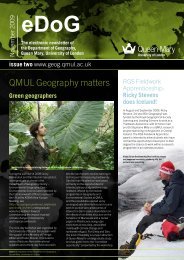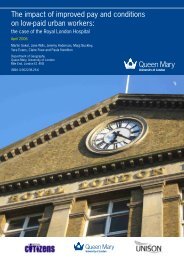The Colombian community in London - Geography - Queen Mary ...
The Colombian community in London - Geography - Queen Mary ...
The Colombian community in London - Geography - Queen Mary ...
- No tags were found...
Create successful ePaper yourself
Turn your PDF publications into a flip-book with our unique Google optimized e-Paper software.
By the end of the 2000s, emigration from Colombia was <strong>in</strong>creas<strong>in</strong>g with 1 <strong>in</strong> 10 <strong>Colombian</strong>s<br />
liv<strong>in</strong>g abroad (McIlwa<strong>in</strong>e and Bermudez, 2011). In <strong>London</strong>, over time, the elite <strong>Colombian</strong>s<br />
liv<strong>in</strong>g <strong>in</strong> <strong>London</strong> who had been arriv<strong>in</strong>g throughout the twentieth century, mostly diplomats,<br />
artists and bus<strong>in</strong>ess people, were jo<strong>in</strong>ed by trade unionists, political activists and work<strong>in</strong>g class<br />
migrants. Indeed, <strong>in</strong> recent years, there have been important flows of students and<br />
professional migrants arriv<strong>in</strong>g <strong>in</strong> <strong>London</strong> which also reflects the <strong>in</strong>troduction of managed<br />
migration policies that favour high skilled migrants as well as the wider diversification of the<br />
population. In addition, secondary migration from other EU countries, especially Spa<strong>in</strong>, has<br />
become an important dynamic among <strong>Colombian</strong>s. Indeed, <strong>in</strong> a survey conducted <strong>in</strong> the mid-<br />
2000s, it was reported that 60% of <strong>Colombian</strong>s <strong>in</strong> <strong>London</strong> were either EU citizens or<br />
permanent residents (Guarnizo, 2008). Overall then, <strong>in</strong> the 2000s, the Lat<strong>in</strong> American<br />
<strong>community</strong> has cont<strong>in</strong>ued to grow despite <strong>in</strong>creas<strong>in</strong>g restrictions on immigration to the UK.<br />
<strong>Colombian</strong>s have been central <strong>in</strong> the emergence of bus<strong>in</strong>esses, media and events aimed at<br />
the Lat<strong>in</strong> American population more broadly. <strong>The</strong>se <strong>in</strong>cluded several newspapers <strong>in</strong> Spanish<br />
(Express News, Extra), large scale events such as the Carnaval del Pueblo <strong>in</strong> Burgess Park <strong>in</strong><br />
South <strong>London</strong> as well as shopp<strong>in</strong>g centres such as Seven Sisters and Elephant and Castle.<br />
In terms of how many <strong>Colombian</strong>s currently reside <strong>in</strong> the UK and <strong>in</strong> <strong>London</strong> <strong>in</strong> particular, it has<br />
been <strong>in</strong>formally estimated that there are between 50,000-70,000, with most liv<strong>in</strong>g <strong>in</strong> <strong>London</strong><br />
(Guarnizo, 2008; McIlwa<strong>in</strong>e, 2005). Recent official statistics from the Annual Population<br />
Survey (APS) <strong>in</strong> 2008 shows that there were 24,040 <strong>Colombian</strong>s liv<strong>in</strong>g <strong>in</strong> the UK, of which<br />
15,271 were <strong>in</strong> <strong>London</strong>. However, this excludes irregular migrants, as well as those from the<br />
second generation. 2 In a more comprehensive estimate of the Lat<strong>in</strong> American <strong>community</strong> as a<br />
whole also based on the APS, there was an estimated total of 113,578 Lat<strong>in</strong> Americans <strong>in</strong><br />
<strong>London</strong> <strong>in</strong>clud<strong>in</strong>g 17,100 irregular migrants and 17,182 second generation Lat<strong>in</strong> Americans.<br />
<strong>Colombian</strong>s are widely thought to be the second largest national group with<strong>in</strong> the Lat<strong>in</strong><br />
American <strong>community</strong> <strong>in</strong> the UK (with Brazilians be<strong>in</strong>g the largest) (McIlwa<strong>in</strong>e et al, 2011;<br />
L<strong>in</strong>neker and McIlwa<strong>in</strong>e, 2011).<br />
METHODOLOGICAL FRAMEWORK<br />
This report is based on three projects with <strong>Colombian</strong> migrants conducted by the author<br />
between 2004 and 2010. <strong>The</strong> first project was carried out between 2004 and 2005 with 35<br />
<strong>Colombian</strong> migrants 30 <strong>Colombian</strong> migrants and 5 employees from 4 Lat<strong>in</strong> American migrant<br />
organisations (3 of whom were <strong>Colombian</strong> themselves). This research focused on cop<strong>in</strong>g<br />
practices and was conducted among those work<strong>in</strong>g <strong>in</strong> the lower echelons of the labour market<br />
(McIlwa<strong>in</strong>e, 2005).<br />
<strong>The</strong> second project was conducted between 2006 and 2007 among 70 Lat<strong>in</strong> American<br />
migrants of which 28 were <strong>Colombian</strong>s together with a further 10 <strong>community</strong> leaders. In<br />
addition, the author carried out participant observation through membership of the<br />
Management Committee of a Lat<strong>in</strong> American migrant organisation for 2 years between 2006<br />
and 2008. This project also focused on „ord<strong>in</strong>ary‟ migrants work<strong>in</strong>g ma<strong>in</strong>ly <strong>in</strong> low-paid<br />
employment (McIlwa<strong>in</strong>e, 2007).<br />
<strong>The</strong> largest study discussed is a large quantitative and qualitatiave project with the Lat<strong>in</strong><br />
American <strong>community</strong> as a whole across the socio-economic spectrum carried out between<br />
2009 and 2010. <strong>The</strong> research <strong>in</strong>cluded here refers to a short questionnaire survey with 249<br />
<strong>Colombian</strong> migrants of which 100 <strong>in</strong>cluded detailed <strong>in</strong>formation. An additional 11 <strong>in</strong>-depth<br />
<strong>in</strong>terviews were conducted with <strong>Colombian</strong>s, as well as 3 focus groups that all conta<strong>in</strong>ed<br />
<strong>Colombian</strong>s. This project explored a wide range of issues relat<strong>in</strong>g to migration trajectories,<br />
2 For example, <strong>in</strong> January 2010, there were 27,543 <strong>Colombian</strong>s registered at the consulate <strong>in</strong> <strong>London</strong>.<br />
However, this figure <strong>in</strong>cludes those who may have left the country as people do not de-register.<br />
5



